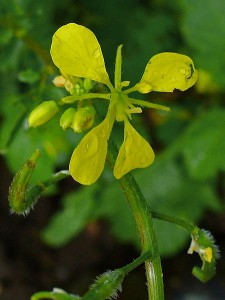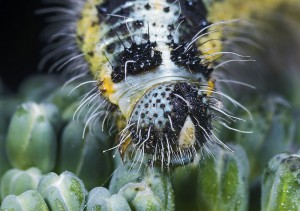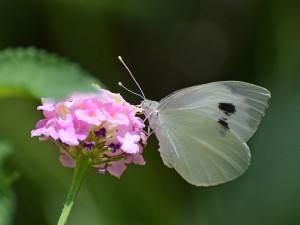Michael Kim
Insects Exploit Multiple Cues of Plants to Govern Behavior
While the research field of signals and cues mostly focuses on animals such as mammals, signals and cues are also very important in plant species. The process of plant pollination involves strategies such as visual and odor cues to attract pollinators that are important for reproductive success. Plants have also evolved strategies to resist and compensate against damage received by herbivores in order to reduce fitness loss. Despite the evolution of these important plant mechanisms, research has widely treated plant-pollinator interactions and plant defense against herbivores as separate phenomena. Both of these characteristics however influence flower traits and plant fitness. In order to lure pollinators, flowering plants emit complex odors and display a wide spectrum of flower colors. Pollinators exploit these visual and odor cues simultaneously, and is important in determining pollinator preferences. Besides pollinators, insect herbivores also induce changes in flower traits and impact plant fitness either directly through flower consumption or indirectly through chemical changes in the plant. These mechanisms may interfere with pollinator attraction by altering the quality of nectar and pollen for example, and therefore influence feeding preferences of flower visitors.
A study done by Lucas-Barbosa et al. (2016) aimed to look at the potential tradeoff between plant defense and pollinator attraction, and how the interaction between the two affects the behavior of flower visitors. In nature, plants are exposed to pollinators and herbivores simultaneously. Therefore, this is an important study because it investigates whether and how herbivore-induced plant responses can affect responses to pollination and lead to changes in pollinator (P. brassicae butterflies and syrphid flies) behavior. The researchers had three objectives with this study. One was to observe how responses of a plant species Brassica nigra to pollination and insect herbivory by Pieris brassicae caterpillars affect the behavior of insect pollinators when caterpillars were feeding on the leaves or flowers of the plant. Second, they wanted to see how plant responses to herbivory and pollination affect the volatile and non-volatile profile of flowering B. nigra plants. Third they wanted to see if plant responses to herbivory interfere with responses to pollination. The authors did not propose any hypotheses or predictions.
B. nigra
http://commons.wikimedia.org/wiki/File:Brassica_nigra_002.JPG
P. brassicae caterpillar
https://commons.wikimedia.org/wiki/File:Pieris_brassicae_(caterpillar)_Portrait.jpg
The results of this study highlighted the importance and interaction of pollination and herbivory, as well as the effects they can have on visitor behavior. Visiting P. brassicae butterflies avoided depositing eggs on plants infested with caterpillars of other P. brassicae. Male and female butterflies rarely visited pollinated flowers and when they did, they spent less time on them than on an unpollinated flower. However, pollination did not affect the behavior of syrphid flies since they visited pollinated and unpollinated flowers equally. Upon herbivore infestation by caterpillars, the B. nigra plants responded with changes in volatile emission in compounds such as benzenoids and fatty acid derivatives. Similarly, pollination also influenced the volatile profile of the plants and so did the combined effects of pollination plus herbivory. The non-volatile profile (including glycosides of isorhamnetin and kaempferol) of pollinated flowers differed from that of unpollinated flowers and from that of plants subjected to pollination plus herbivory.
The results showed that these plants responded to herbivory and pollination with changes in the volatile and non-volatile chemical profiles of flowers. Butterflies responded to changes induced by pollination and herbivory, and syrphid flies to changes induced by herbivory. The data suggested that herbivore-induced changes in plants may affect attraction of pollinators because such changes can interfere with local responses to pollination, influencing the cues exploited by flower visiting insects. Plant responses to pollination are important in optimizing reproductive success because only the flowers that have been pollinated go through changes that guide pollinators to unpollinated flowers. The results of this study showed that butterflies rarely visited pollinated plants and suggested that butterflies perceived the changes induced by pollination and avoided flowers that provide little rewards, such as low nectar. Interestingly, the two pollinating insect species exploited different cues depending on the resource they searched for. For example, herbivory influenced oviposition preference of the butterflies but not their flower-feeding preferences. Induced responses of the plant to herbivory influenced pollinator behavior, and also interfered with plant responses to pollination that are important in plant-pollinator interactions. The changes in chemical compounds induced by pollination may also have resulted in changes in the visual cues used by pollinators such as nectar guides or overall flower color as well as the synthesis of new volatile and non-volatile aromatic compounds.
https://commons.wikimedia.org/wiki/File:Pieris_brassicae_-_White_Butterfly_-_Cabbage_Butterfly_02.JPG
https://commons.wikimedia.org/wiki/File:Pieris_brassicae_-_White_Butterfly_-_Cabbage_Butterfly_02.JPG
This study showed that plants respond to herbivory and pollination with changes in flower traits that can influence the specificity of color-odor combinations, which in turn influences behavior of visiting insects. Responses to herbivory can interfere with response to pollination that is essential in maximizing plant fitness, presenting a tradeoff. Plants present visual and auditory cues that are mediated by volatile and non-volatile compound emission, and these cues can present unique and reinforcing information to visiting insects. These compounds play roles in plant defense against herbivores, are used as oviposition cues, and also color flowers for pollinator attraction. These insects can exploit the cues of the plants to determine whether they want to pollinate or not, or consume/lay eggs on or not. Sensory adaptations drive evolution as well as the fitness of this plant species. This research has broad implications at both the ecological and sensory (physiological) level. It suggested that behavior of insects could be shaped by multiple plant cues, their interactions, and their responses to pollination and herbivory. This study also established an insightful link between the strategies of plants and other animals that they use in order to more efficiently convey information related to predation, reproduction, and communication.
Source: Lucas-Barbosa, D., Sun, P., Hakman, A., van Beek, T.A., van Loon, J.J.A. and Dicke, M. (2016). Visual and odour cues: plant responses to pollination and herbivory affect the behavior of flower visitors. Functional Ecology, 30, 431-441.



